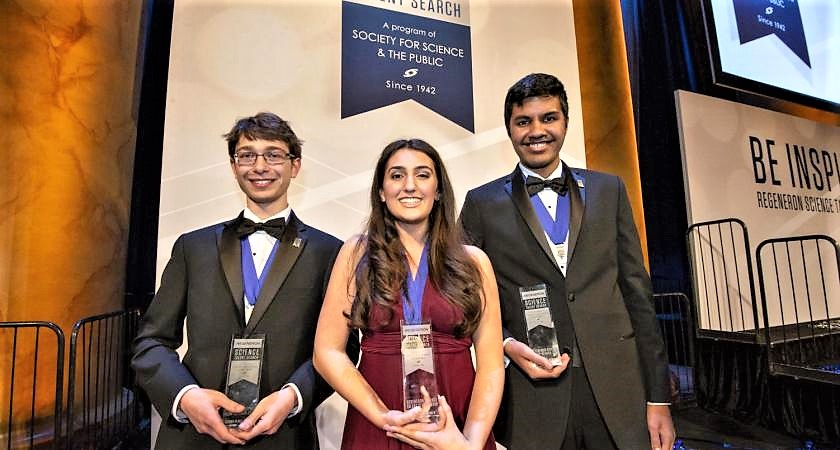America’s Got STEM Talent!
One finalist developed mathematical and algorithmic models for predicting refugee migrations in times of crisis. Another built a wind tunnel and flow tank in her basement to test the design of a “Virtual Winglet” that not only could enhance the stability and efficiency of U.S. military aircraft but also reduce carbon dioxide emissions by as much as 112 million tons a day.
Ingenuity was on full display March 10 – 12 at the 2019 Regeneron Science Talent Search, the nation’s oldest and most prestigious youth STEM competition. So was diversity. Of the 40 finalists culled from more than 2,000 who submitted projects, 18 were young women. More than half – 27 students – came from immigrant families and five were immigrants themselves.
Ana Humphrey, 18, from T. C. Williams High School in Alexandria, Va., (photo, center) won top honors and $250,000 for her mathematical model to determine the possible locations of exoplanets — planets outside our solar system — that may have been missed by NASA’s Kepler Space Telescope. These distant bodies are thought to be formed in densely packed systems and typically are revealed when their transit dims a star’s light. But planets outside of Earth’s “plane of view” or too small to dim much starlight may go undetected. Ana, the first Hispanic first-place winner in 20 years, used her model to find “unpacked” spaces where as many as 560 new planets might fit, and identified 96 locations as primary search targets. Her research could aid our understanding of the formation of planets and inform our search for life in outer space. Read the Washington Post profile.
Second-place winner Samuel Weissman, 17, from Harriton High School in Rosemont, Pa., (photo, left) received $175,000 for his cellular molecular biology project analyzing the genetic makeup of HIV in two patients on long-term anti-retroviral therapy to understand why they continued to have “reservoirs” of treatment-resistant HIV-infected cells. His research suggests that the immune system slowly kills HIV-infected cells but that some survive by clonal expansion, therefore forming a reservoir of infected cells, which expands our understanding of HIV and may impact future treatment approaches.
Third place winner Adam Ardeishar, 17, from Thomas Jefferson High School for Science and Technology in Alexandria, Va., (photo, right) received $175,000 for his project combining the classic “coupon collector” math problem and extreme value theory, which is used to determine the likelihood of a maximal event, such as a 1,000-year flood. By integrating these two concepts, he developed a way to calculate the average maximum values of distributional data sets, which could be applied to predicting the expected amount of time for a given number of different randomly-timed events to occur.
Several projects tackled problems in the students’ own communities. Anjali Chadha, 16. from duPont Manual High School in Louisville, Ky., was inspired to develop a portable, affordable, and easy-to-use arsenic sensor after learning that water sources some 90 miles from her home were contaminated with this carcinogen. “I had no experience with engineering,” she told eGFI while explaining her project at the awards gala. Aided by 3-D printing, Chadha was able to make “dozens of iterations” to rapidly modify electrical components and create her device, which achieves an error rate of 5 percent or less.
All told, Regeneron – a biotech pharmaceutical firm started by two Science Talent Search alumni – awarded $3.1 million in prizes to this year’s Science Talent Search competitors, including $2,000 to each of the top 300 scholars and their schools. Of the 40 finalists, the top 10 received awards ranging from $40,000 to $250,000, with the remaining 30 receiving $25,000. Finalists have gone on to become Nobel laureates, inventors, and researchers.
Filed under: K-12 Education News, Special Features
Tags: 2019 Regeneron Science Talant Search, Society for Science and the Public









